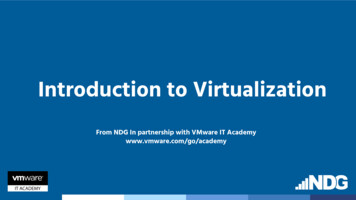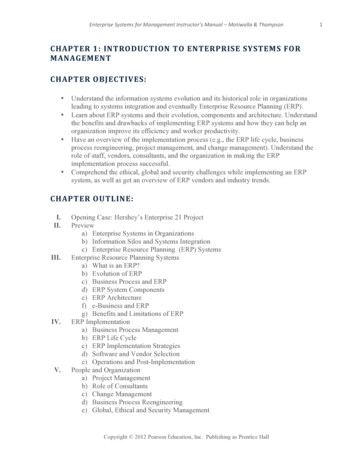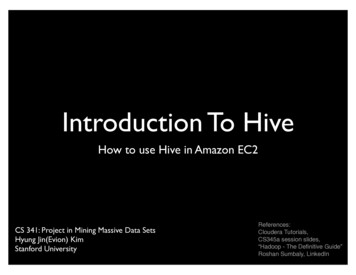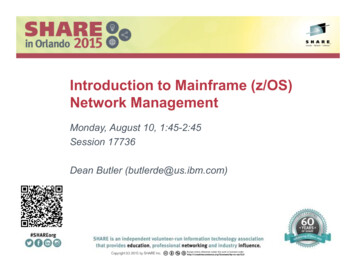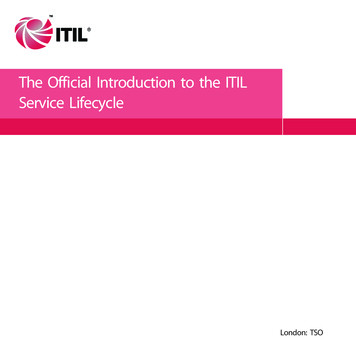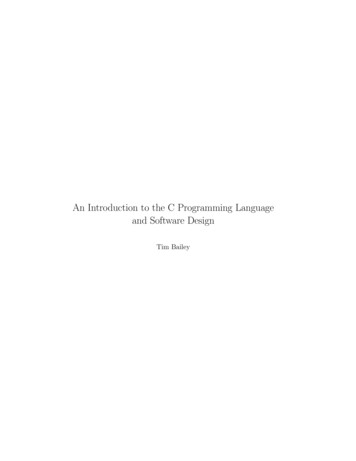
Transcription
An Introduction to the C Programming Languageand Software DesignTim Bailey
PrefaceThis textbook began as a set of lecture notes for a first-year undergraduate software engineeringcourse in 2003. The course was run over a 13-week semester with two lectures a week. The intentionof this text is to cover topics on the C programming language and introductory software design insequence as a 20 lecture course, with the material in Chapters 2, 7, 8, 11, and 13 well served bytwo lectures apiece. Ample cross-referencing and indexing is provided to make the text a servicablereference, but more complete works are recommended. In particular, for the practicing programmer,the best available tutorial and reference is Kernighan and Ritchie [KR88] and the best in-depthreference is Harbison and Steele [HS95, HS02]. The influence of these two works on this text isreadily apparent throughout.What sets this book apart from most introductory C-programming texts is its strong emphasison software design. Like other texts, it presents the core language syntax and semantics, but it alsoaddresses aspects of program composition, such as function interfaces (Section 4.5), file modularity(Section 5.7), and object-modular coding style (Section 11.6). It also shows how to design for errorsusing assert() and exit() (Section 4.4). Chapter 6 introduces the basics of the software designprocess—from the requirements and specification, to top-down and bottom-up design, to writingactual code. Chapter 14 shows how to write generic software (i.e., code designed to work with avariety of different data types).Another aspect that is not common in introductory C texts is an emphasis on bitwise operations.The course for which this textbook was originally written was prerequisite to an embedded systemscourse, and hence required an introduction to bitwise manipulations suitable for embedded systemsprogramming. Chapter 12 provides a thorough discussion of bitwise programming techniques.The full source code for all significant programs in this text can be found on the web at theaddress dex.html. Given the volatilenature of the web, this link may change in subsequent years. If the link is broken, please email meat tbailey@acfr.usyd.edu.au and I will attempt to rectify the problem.This textbook is a work in progress and will be refined and possibly expanded in the future. Nodoubt there are errors and inconsistencies—both technical and grammatical—although hopefullynothing too seriously misleading. If you find a mistake or have any constructive comments pleasefeel free to send me an email. Also, any interesting or clever code snippets that might be incorporatedin future editions are most welcome.Tim Bailey 2005.Draft 0.6 (July 12, 2005)TODO:- complete Chapter 16- complete appendices- complete the indexi
ContentsPrefaceiContentsii1 Introduction1.1 Programming and Programming Languages . . . .1.2 The C Programming Language . . . . . . . . . . .1.3 A First Program . . . . . . . . . . . . . . . . . . .1.4 Variants of Hello World . . . . . . . . . . . . . . .1.5 A Numerical Example . . . . . . . . . . . . . . . .1.6 Another Version of the Conversion Table Example1.7 Organisation of the Text . . . . . . . . . . . . . . .112345662 Types, Operators, and Expressions2.1 Identifiers . . . . . . . . . . . . . .2.2 Types . . . . . . . . . . . . . . . .2.3 Constants . . . . . . . . . . . . . .2.4 Symbolic Constants . . . . . . . .2.5 printf Conversion Specifiers . . .2.6 Declarations . . . . . . . . . . . . .2.7 Arithmetic Operations . . . . . . .2.8 Relational and Logical Operations2.9 Bitwise Operators . . . . . . . . .2.10 Assignment Operators . . . . . . .2.11 Type Conversions and Casts . . . .8881011121313141515163 Branching and Iteration3.1 If-Else . . . . . . . . . . .3.2 ?: Conditional Expression3.3 Switch . . . . . . . . . . .3.4 While Loops . . . . . . . .3.5 Do-While Loops . . . . .3.6 For Loops . . . . . . . . .3.7 Break and Continue . . .3.8 Goto . . . . . . . . . . . .1717191920212122234 Functions4.1 Function Prototypes4.2 Function Definition .4.3 Benefits of Functions4.4 Designing For Errors.2525252829.ii
4.54.6Interface Design . . . . . . . . . . . . . . . . . . . . . . . . . . . . . . . . . . . . . . .The Standard Library . . . . . . . . . . . . . . . . . . . . . . . . . . . . . . . . . . .31325 Scope and Extent5.1 Local Scope and Automatic Extent . . . . . . .5.2 External Scope and Static Extent . . . . . . . .5.3 The static Storage Class Specifier . . . . . . .5.4 Scope Resolution and Name Hiding . . . . . . .5.5 Summary of Scope and Extent Rules . . . . . .5.6 Header Files . . . . . . . . . . . . . . . . . . . .5.7 Modular Programming: Multiple File Programs.33333435363838396 Software Design6.1 Requirements and Specification . . . . . . .6.2 Program Flow and Data Structures . . . . .6.3 Top-down and Bottom-up Design . . . . . .6.4 Pseudocode Design . . . . . . . . . . . . . .6.5 Case Study: A Tic-Tac-Toe Game . . . . .6.5.1 Requirements . . . . . . . . . . . . .6.5.2 Specification . . . . . . . . . . . . .6.5.3 Program Flow and Data Structures .6.5.4 Bottom-Up Design . . . . . . . . . .6.5.5 Top-Down Design . . . . . . . . . .6.5.6 Benefits of Modular Design . . . . .4141424243444444454547487 Pointers7.1 What is a Pointer? . . . . .7.2 Pointer Syntax . . . . . . .7.3 Pass By Reference . . . . .7.4 Pointers and Arrays . . . .7.5 Pointer Arithmetic . . . . .7.6 Return Values and Pointers7.7 Pointers to Pointers . . . .7.8 Function Pointers . . . . . .4949505253545657578 Arrays and Strings8.1 Array Initialisation . . . . . . . .8.2 Character Arrays and Strings . .8.3 Strings and the Standard Library8.4 Arrays of Pointers . . . . . . . .8.5 Multi-dimensional Arrays . . . .5959606263659 Dynamic Memory9.1 Different Memory Areas in C . . . . . .9.2 Standard Memory Allocation Functions9.3 Dynamic Memory Management . . . . .9.4 Example: Matrices . . . . . . . . . . . .9.5 Example: An Expandable Array . . . .686869707275.iii
10 The10.110.210.3C PreprocessorFile Inclusion . . . . . . . . .Symbolic Constants . . . . .Macros . . . . . . . . . . . . .10.3.1 Macro Basics . . . . .10.3.2 More Macros . . . . .10.3.3 More Complex Macros10.4 Conditional Compilation . . .797979808182838411 Structures and Unions11.1 Structures . . . . . . . . . . . . . . .11.2 Operations on Structures . . . . . .11.3 Arrays of Structures . . . . . . . . .11.4 Self-Referential Structures . . . . . .11.5 Typedefs . . . . . . . . . . . . . . . .11.6 Object-Oriented Programming Style11.7 Expandable Array Revisited . . . . .11.8 Unions . . . . . . . . . . . . . . . . .86868788899193949712 Bitwise Operations12.1 Binary Representations . . . . . .12.2 Bitwise Operators . . . . . . . . .12.2.1 AND, OR, XOR, and NOT12.2.2 Right Shift and Left Shift .12.2.3 Operator Precedence . . . .12.3 Common Bitwise Operations . . .12.4 Bit-fields . . . . . . . . . . . . . . .999910010010110210210313 Input and Output13.1 Formatted IO . . . . . . . . . . . . . . .13.1.1 Formatted Output: printf() . .13.1.2 Formatted Input: scanf() . . .13.1.3 String Formatting . . . . . . . .13.2 File IO . . . . . . . . . . . . . . . . . . .13.2.1 Opening and Closing Files . . . .13.2.2 Standard IO . . . . . . . . . . .13.2.3 Sequential File Operations . . . .13.2.4 Random Access File Operations13.3 Command-Shell Redirection . . . . . . .13.4 Command-Line Arguments . . . . . . .10510510510710910910911011011211311414 Generic Programming14.1 Basic Generic Design: Typedefs, Macros, and Unions14.1.1 Typedefs . . . . . . . . . . . . . . . . . . . .14.1.2 Macros . . . . . . . . . . . . . . . . . . . . .14.1.3 Unions . . . . . . . . . . . . . . . . . . . . . .14.2 Advanced Generic Design: void * . . . . . . . . . .14.2.1 Case Study: Expandable Array . . . . . . . .14.2.2 Type Specific Wrapper Functions . . . . . . .14.2.3 Case Study: qsort() . . . . . . . . . . . . .115115115116116117117121123.iv
15 Data Structures15.1 Efficiency and Time Complexity15.2 Arrays . . . . . . . . . . . . . . .15.3 Linked Lists . . . . . . . . . . . .15.4 Circular Buffers . . . . . . . . . .15.5 Stacks . . . . . . . . . . . . . . .15.6 Queues . . . . . . . . . . . . . . .15.7 Binary Trees . . . . . . . . . . .15.8 Hash Tables . . . . . . . . . . . .12612612712712913113113213516 C in the Real World16.1 Further ISO C Topics . . . . . . . . . . . .16.2 Traditional C . . . . . . . . . . . . . . . . .16.3 Make Files . . . . . . . . . . . . . . . . . . .16.4 Beyond the C Standard Library . . . . . . .16.5 Interfacing With Libraries . . . . . . . . . .16.6 Mixed Language Programming . . . . . . .16.7 Memory Interactions . . . . . . . . . . . . .16.8 Advanced Algorithms and Data Structures.138138139139139140140140141.A Collected Style Rules and Common Errors142A.1 Style Rules . . . . . . . . . . . . . . . . . . . . . . . . . . . . . . . . . . . . . . . . . 142A.2 Common Errors . . . . . . . . . . . . . . . . . . . . . . . . . . . . . . . . . . . . . . . 142B The Compilation Process143Bibliography144Index146v
Chapter 1IntroductionThis textbook was written with two primary objectives. The first is to introduce the C programming language. C is a practical and still-current software tool; it remains one of the most popularprogramming languages in existence, particularly in areas such as embedded systems. C facilitateswriting code that is very efficient and powerful and, given the ubiquity of C compilers, can be easilyported to many different platforms. Also, there is an enormous code-base of C programs developedover the last 30 years, and many systems that will need to be maintained and extended for manyyears to come.The second key objective is to introduce the basic concepts of software design. At one-level thisis C-specific: to learn to design, code and debug complete C programs. At another level, it is moregeneral: to learn the necessary skills to design large and complex software systems. This involveslearning to decompose large problems into manageable systems of modules; to use modularity andclean interfaces to design for correctness, clarity and flexibility.1.1Programming and Programming LanguagesThe native language of a computer is binary—ones and zeros—and all instructions and data mustbe provided to it in this form. Native binary code is called machine language. The earliest digitalelectronic computers were programmed directly in binary, typically via punched cards, plug-boards,or front-panel switches. Later, with the advent of terminals with keyboards and monitors, suchprograms were written as sequences of hexadecimal numbers, where each hexadecimal digit representsa four binary digit sequence. Developing correct programs in machine language is tedious andcomplex, and practical only for very small programs.In order to express operations more abstractly, assembly languages were developed. These languages have simple mnemonic instructions that directly map to a sequence of machine languageoperations. For example, the MOV instruction moves data into a register, the ADD instruction addsthe contents of two registers together. Programs written in assembly language are translated tomachine code using an assembler program. While assembly languages are a considerable improvement on raw binary, they still very low-level and unsuited to large-scale programming. Furthermore,since each processor provides its own assembler dialect, assembly language programs tend to benon-portable; a program must be rewritten to run on a different machine.The 1950s and 60s saw the introduction of high-level languages, such as Fortran and Algol.These languages provide mechanisms, such as subroutines and conditional looping constructs, whichgreatly enhance the structure of a program, making it easier to express the progression of instructionexecution; that is, easier to visualise program flow. Also, these mechanisms are an abstraction ofthe underlying machine instructions and, unlike assembler, are not tied to any particular hardware.Thus, ideally, a program written in a high-level language may be ported to a different machine and1
run without change. To produce executable code from such a program, it is translated to machinespecific assembler language by a compiler program, which is then coverted to machine code by anassembler (see Appendix B for details on the compilation process).Compiled code is not the only way to execute a high-level program. An alternative is to translatethe program on-the-fly using an interpreter program (e.g., Matlab, Python, etc). Given a text-filecontaining a high-level program, the interpreter reads a high-level instruction and then executes thenecessary set of low-level operations. While usually slower than a compiled program, interpretedcode avoids the overhead of compilation-time and so is good for rapid implementation and testing.Another alternative, intermediate between compiled and interpreted code, is provided by a virtualmachine (e.g., the Java virtual machine), which behaves as an abstract-machine layer on top of areal machine. A high-level program is compiled to a special byte-code rather than machine language,and this intermediate code is then interpreted by the virtual machine program. Interpreting bytecode is usually much faster than interpreting high-level code directly. Each of these representationshas is relative advantages: compiled code is typically fastest, interpreted code is highly portable andquick to implement and test, and a virtual machine offers a combination of speed and portability.The primary purpose of a high-level language is to permit more direct expression of a programmer’s design. The algorithmic structure of a program is more apparent, as is the flow of informationbetween different program components. High-level code modules can be designed to “plug” togetherpiece-by-piece, allowing large programs to be built out of small, comprehensible parts. It is important to realise that programming in a high-level language is about communicating a software designto programmers not to the computer. Thus, a programmer’s focus should be on modularity andreadability rather than speed. Making the program run fast is (mostly) the compiler’s concern.11.2The C Programming LanguageC is a general-purpose programming language, and is used for writing programs in many different domains, such as operating systems, numerical computing, graphical applications, etc. It is asmall language, with just 32 keywords (see [HS95, page 23]). It provides “high-level” structuredprogramming constructs such as statement grouping, decision making, and looping, as well as “lowlevel” capabilities such as the ability to manipulate bytes and addresses.Since C is relatively small, it can be described in a small space, and learned quickly. Aprogrammer can reasonably expect to know and understand and indeed regularly use theentire language [KR88, page 2].C achieves its compact size by providing spartan services within the language proper, foregoingmany of the higher-level features commonly built-in to other languages. For example, C providesno operations to deal directly with composite objects such as lists or arrays. There are no memorymanagement facilities apart from static definition and stack-allocation of local variables. And thereare no input/output facilities, such as for printing to the screen or writing to a file.Much of the functionality of C is provided by way of software routines called functions. Thelanguage is accompanied by a standard library of functions that provide a collection of commonlyused operations. For example, the standard function printf() prints text to the screen (or, moreprecisely, to standard output—which is typically the screen). The standard library will be usedextensively throughout this text; it is important to avoid writing your own code when a correct andportable implementation already exists.1 Of course, efficiency is also the programmer’s responsibility, but it should not be to the detriment of clarity, seeSection 15.1 for further discussion.2
1.3A First ProgramA C program, whatever its size, consists of functions and variables. A function containsstatements that specify the computing operations to be done, and variables store valuesused during the computation [KR88, page 6].The following program is the traditional first program presented in introductory C courses andtextbooks.12345671/* First C program: Hello World */#include stdio.h int main(void){printf("Hello World!\n");}Comments in C start with /* and are terminated with */. They can span multiple lines and are notnestable. For example,/* this attempt to nest two comments /* results in just one comment,ending here: */ and the remaining text is a syntax error. */2Inclusion of a standard library header-file. Most of C’s functionality comes from libraries. Headerfiles contain the information necessary to use these libraries, such as function declarations andmacros.4All C programs have main() as the entry-point function. This function comes in two forms:int main(void)int main(int argc, char *argv[])The first takes no arguments, and the second receives command-line arguments from the environmentin which the program was executed—typically a command-shell. (More on command-line argumentsin Section 13.4.) The function returns a value of type int (i.e., an integer ).25 and 76The braces { and } delineate the extent of the function block. When a function completes, theprogram returns to the calling function. In the case of main(), the program terminates and controlreturns to the environment in which the program was executed. The integer return value of main()indicates the program’s exit status to the environment, with 0 meaning normal termination.This program contains just one statement: a function call to the standard library function printf(),which prints a character string to standard output (usually the screen). Note, printf() is not a partof the C language, but a function provided by the standard library (declared in header stdio.h).The standard library is a set of functions mandated to exist on all systems conforming to the ISO Cstandard. In this case, the printf() function takes one argument (or input parameter): the stringconstant "Hello World!\n". The \n at the end of the string is an escape character to start a newline. Escape characters provide a mechanism for representing hard-to-type or invisible characters(e.g., \t for tab, \b for backspace, \" for double quotes). Finally, the statement is terminated witha semicolon (;). C is a free-form language, with program meaning unaffected by whitespace in mostcircumstances. Thus, statements are terminated by ; not by a new line.2 You may notice in the example program above, that main() says it returns int in its interface declaration, butin fact does not return anything; the function body (lines 5–7) contains no return statement. The reason is that formain(), and main() only, an explicit return statement is optional (see Chapter 4 for more details).3
1.4Variants of Hello WorldThe following program produces identical output to the previous example. It shows that a new lineis not automatic with each call to printf(), and subsequent strings are simply abutted togetheruntil a \n escape character occurs.123456789/* Hello World version 2 */#include stdio.h int main(void){printf("Hello ");printf("World!");printf("\n");}The next program also prints “Hello World!” but, rather than printing the whole string in onego, it prints it one character at a time. This serves to demonstrate several new concepts, namely:types, variables, identifiers, pointers, arrays, array subscripts, the \0 (NUL) escape character, logicaloperators, increment operators, while-loops, and string formatting.This may seem a lot, but don’t worry—you don’t have to understand it all now, and all will beexplained in subsequent chapters. For now, suffice to understand the basic structure of the code: astring, a loop, an index parameter, and a print statement.12345678910111213146–7/* Hello World version 3 */#include stdio.h int main(void){int i 0;char *str "Hello World!\n";/* Print each character until reach ’\0’ */while (str[i] ! ’\0’)printf("%c", str[i ]);}return 0;All variables must be declared before they are used. They must be declared at the top of a blockbefore any statements; (a block is a section of code enclosed in brackets { and }). They may beinitialised by a constant or an expression when declared.6The variable with identifier i is of type int, an integer, initialised to zero.7The variable with identifier str is of type char *, which is a pointer to a character. In this case,str refers to the characters in a string constant.10–11A while-loop iterates through each character in the string and prints them one at a time. The loopexecutes while ever the expression (str[i] ! ’\0’) is non-zero. (Non-zero corresponds to TRUEand zero to FALSE.) The operator ! means NOT EQUAL TO. The term str[i] refers to the i-thcharacter in the string (where str[0] is ’H’). All string constants are implicitly appended with aNUL character, specified by the escape character ’\0’.11The while-loop executes the following statement while ever the loop expression is TRUE. In thiscase, the printf() takes two arguments—a format string "%c" and a parameter str[i ]—andprints the i-th character of str. The expression i is called the post-increment operator ; it returnsthe value of i and then increments it i i 1.4
13Unlike the previous versions of this program, this one includes an explicit return statement for theprogram’s exit status.Style note. Throughout this text take notice of the formatting style used in the example code,particularly indentation. Indentation is a critical component in writing clear C programs. Thecompiler does not care about indentation, but it makes the program easier to read for 6–79–1011–13A Numerical Example/* Fahrenheit to Celcius conversion table (K&R page 12) */#include stdio.h int main(void){float fahr, celsius;int lower, upper, step;/* Set lower and upper limits of the temperature table (in Fahrenheit) along with the* table increment step-size */lower 0;upper 300;step 20;}/* Create conversion table using the equation: C (5/9)(F - 32) */fahr lower;while (fahr upper) {celsius (5.0/9.0) * (fahr 32.0);printf("%3.0f \t%6.1f\n", fahr, celsius);fahr step;}This program uses several variables. These must be declared at the top of a block, before anystatements. Variables are specified types, which are int and float in this example.Note, the * beginning line 10 is not required and is there for purely aesthetic reasons.These first three statements in the program initialise the three integer variables.16The floating-point variable fahr is initialised. Notice that the two variables are of different type (intand float). The compiler performs automatic type conversion for compatible types.17–21The while-loop executes while ever the expression (fahr upper) is TRUE. The operator means LESS THAN OR EQUAL TO. This loop executes a compound statement enclosed in braces—these are the three statements on lines 18–20.18This statement performs the actual numerical computations for the conversion and stores the resultin the variable celcius.19The printf() statement here consists of a format string and two variables fahr and celcius. Theformat string has two conversion specifiers, %3.0f and %6.1f, and two escape characters, tab andnew-line. (The conversion specifier %6.1f, for example, formats a floating-point number allowingspace for at least six digits and printing one digit after the decimal point. See Section 13.1.1 formore information on printf() and conversion specifiers.)20The assignment operator produces an expression equivalent to fahr fahr step.5
Style note. Comments should be used to clarify the code where necessary. They should explainintent and point-out algorithm subtleties. They should avoid restating code idioms. Careful choiceof identifiers (i.e., variable names, etc) can greatly reduce the number of comments required toproduce readable code.1.6Another Version of the Conversion Table ExampleThis variant of the conversion table example produces identical output to the first, but serves tointroduce symbolic constants and the for-loop.1234567891011121314/* Fahrenheit to Celcius conversion table (K&R page 15) */#include stdio.h #define LOWER 0 /* lower limit of temp. table (in Fahrenheit) */#define UPPER 300 /* upper limit */#define STEP 20/* step size */int main(void){int fahr;}for (fahr LOWER; fahr UPPER; fahr STEP)printf("%3d \t%6.1f\n", fahr, (5.0/9.0) * (fahr 32.0));4–6Symbolic constants are names that represent numerical constants. These are specified by #define,and mean that we can avoid littering our code with numbers. Numbers scattered through code arecalled “magic numbers” and should always be avoided. (There are rare exceptions where a literalconstant is okay; the most common example is the number 0 to begin a loop over an array.)12–13The for-loop has three components separated by two semicolons (;). The first initialises the loop,the second tests the condition (identical to the while-loop), and the third is an expression executedafter each loop iteration. Notice that the actual conversion expression appears inside the printf()statement; an expression can be used wherever a variable can.Style note. Variables should always begin with a lowercase letter, and multi-word names shouldbe written either like this or likeThis. Symbolic constants should always be UPPERCASE todistinguish them from variables.1.7Organisation of the TextThis text is organised in a sequential fashion—from fundamentals to higher-level constructs andsoftware design issues. The core language is covered in Chapters 2–5 and 7–13. (The materialrequired to understand the examples in this chapter is covered in Chapters 2 and 3, and Sections7.1, 7.2, and 8.2.)Throughout the text, design techniques and good programming practice are emphasised to encourage a coding style conducive to building large-scale software systems. Good quality software notonly works correctly, but is easy to read and understand, written in a clean, consistent style, andstructured for future maintenance and extension. The basic process of program design is presentedin Chapter 6.Chapters 14 and 15 describe more advanced use of the C language, and are arguably the mostinteresting chapters of the book as they show how the individual language features combine topermit very powerful programming techniques. Chapter 14 discusses generic programming, which6
is the design of functions that can operate on a variety of different data types. Chapter 15 presen
of this text is to cover topics on the C programming language and introductory software design in sequence as a 20 lecture course, with the material in Chapters 2, 7, 8, 11, and 13 well served by two lectures apiece. Ample cross-referencing and indexing is provided to make the text a servi




